Basic Review of Adjectives
Adjectives are used to describe or modify nouns or pronouns. There are different types of adjectives that indicate possession, demonstrate distance, and make comparisons. You must remember how to create the appropriate form of an adjective to match the number and gender of the noun it describes and how to place the adjective correctly in a sentence. A Spanish adjective often follows the noun it modifies (describes), but there are some circumstances in Spanish sentences in which the adjective must be placed before the noun.
Correct gender
In vocabulary lists and in dictionaries, adjectives are always listed in the singular masculine form. In this form, most adjectives end in ‐o, but there are a few that end in ‐e or a consonant.
If an adjective ends in ‐o in its singular masculine form, the final ‐o will change to ‐a when it is used to describe a feminine noun. In the examples below, the definite article is included to remind you of the gender of the noun; you must know the gender of the noun in order to use the adjective correctly.
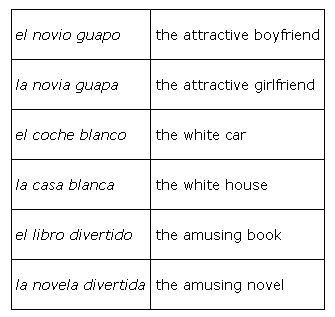
Many commonly used adjectives end in ‐e. Adjectives that end in ‐e do not change endings for feminine nouns.
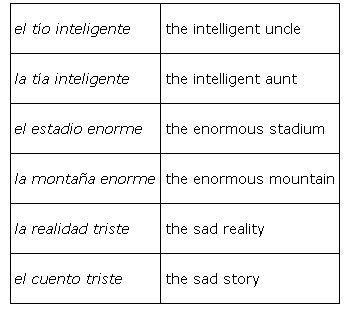
Adjectives that end in a consonant do not change endings to indicate gender.
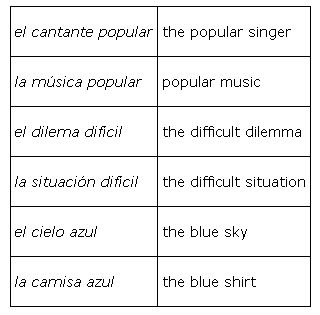
The exceptions to the above rule are adjectives of nationality. Adjectives of nationality that end in ‐ o behave like any other adjective: The ‐o changes to ‐a if the adjective describes a feminine noun. Notice in the examples below that you need not capitalize Spanish adjectives of nationality.
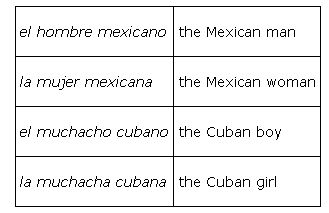
Adjectives of nationality that end in ‐e also behave like other adjectives, except that the same form is used for both masculine and feminine nouns.
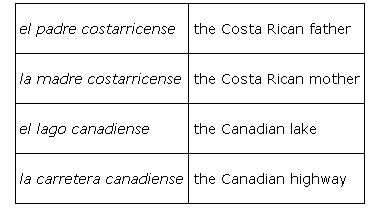
Adjectives of nationality that end in a consonant follow specific rules. Unlike other adjectives, you must add the letter a after the consonant at the end of an adjective of nationality in order to use it with a feminine noun.

Adding a syllable to the end of a word alters where the stress of the word naturally falls. If an adjective of nationality has an accent mark on the last syllable, the accent mark will disappear when you add ‐a to the feminine form.

Using the plural forms of adjectives
When a noun is plural, any adjective that modifies it must also be in a plural form. In addition, the definite article el becomes los and la becomes las when the noun is plural. The plural forms of adjectives are created the same way as the plural forms of nouns.
If an adjective ends in a vowel, add ‐s to make it plural.
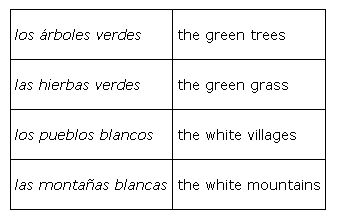
If an adjective ends in a consonant, add ‐es to make it plural.
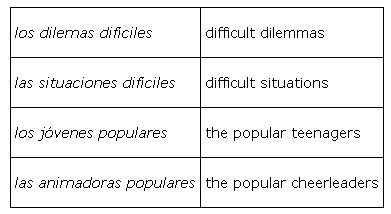
When you add ‐es to pluralize, remember that “ z changes to c when followed by e.”

Placement of adjectives in a sentence
In a Spanish sentence, an adjective is generally placed after the noun it modifies, but some types of adjectives must be placed in front of a noun.
Adjectives that indicate quantity are placed in front of the nouns they quantify. This includes all numbers and any adjectives that indicate amount. Some common adjectives of quantity are listed below.
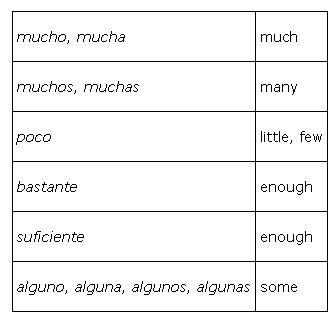
Apocopated is a grammatical term used to indicate that something is shortened. Some adjectives are called “apocopated” because their endings are cut short in specific circumstances. The adjectives listed below lose the final ‐o when immediately followed by a singular masculine noun. These adjectives are usually placed in front of a noun; you should drop the final ‐ o of the adjective only if that noun is singular and masculine, as in the examples below.

|
|
|
|
|
|
|
|
|
|
|
|
|
|
|
|
|
|
|
|
|
|
|
|
|
|
|
|
|
|
|
|
|
|
|
|
|
|
|
|
|
|
|
|
|